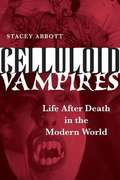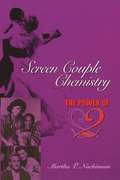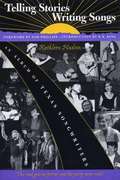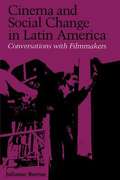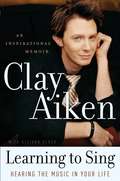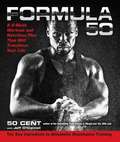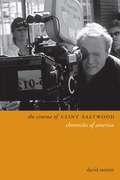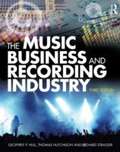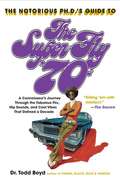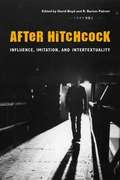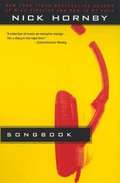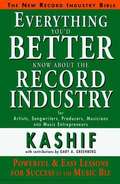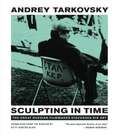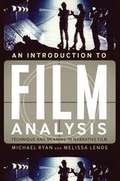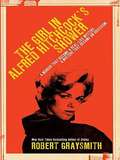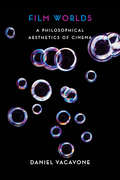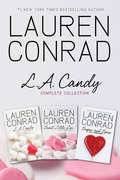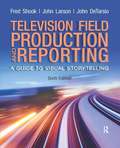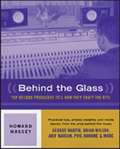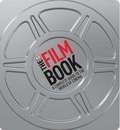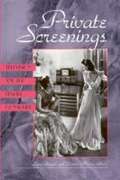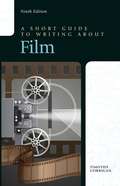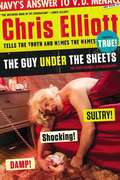- Table View
- List View
Celluloid Vampires
by Stacey AbbottIn 1896, French magician and filmmaker George Méliès brought forth the first celluloid vampire in his film Le manoir du diable. The vampire continues to be one of film's most popular gothic monsters and in fact, today more people become acquainted with the vampire through film than through literature, such as Bram Stoker's classic Dracula. How has this long legacy of celluloid vampires affected our understanding of vampire mythology? And how has the vampire morphed from its folkloric and literary origins? In this entertaining and absorbing work, Stacey Abbott challenges the conventional interpretation of vampire mythology and argues that the medium of film has completely reinvented the vampire archetype. Rather than representing the primitive and folkloric, the vampire has come to embody the very experience of modernity. No longer in a cape and coffin, today's vampire resides in major cities, listens to punk music, embraces technology, and adapts to any situation. Sometimes she's even female. With case studies of vampire classics such as Nosferatu, Martin, Blade, and Habit, the author traces the evolution of the American vampire film, arguing that vampires are more than just blood-drinking monsters; they reflect the cultural and social climate of the societies that produce them, especially during times of intense change and modernization. Abbott also explores how independent filmmaking techniques, special effects makeup, and the stunning and ultramodern computer-generated effects of recent films have affected the representation of the vampire in film.
Screen Couple Chemistry
by Martha P. NochimsonAstaire and Rogers, Tracy and Hepburn. Just the mention of their names evokes the powerful chemistry between these screen couples, which utterly transcended the often formulaic films in which they appeared together. Indeed, watching the synergistic flow of energy between charismatic screen partners is one of the great pleasures of cinema and television, as well as an important vehicle for thinking through issues of intimacy and gender relations. In this book, Martha P. Nochimson engages in a groundbreaking study of screen couple chemistry. She begins by classifying various types of couples to define what sets the synergistic couple apart from other onscreen pairings. Then she moves into extended discussions of four enduring screen couples-Maureen O'Sullivan/Johnny Weissmuller, Myrna Loy/William Powell, Fred Astaire/Ginger Rogers, and Katharine Hepburn/Spencer Tracy. Using theories of neuroscience, she demonstrates that their onscreen chemistry is a very real phenomenon, powerful enough to subvert conventional formulations of male/female relations. Material she has uncovered in the infamous Production Code Administration files illuminates the historical context of her contentions. Finally, Nochimson traces the screen couple to its present-day incarnation in such pairs as Woody Allen/Diane Keaton, Scully/Mulder of The X-Files, and Cliff/Claire Huxtable of The Cosby Show.
Telling Stories, Writing Songs: An Album of Texas Songwriters
by Kathleen HudsonWillie Nelson, Joe Ely, Marcia Ball, Tish Hinojosa, Stevie Ray Vaughan, Lyle Lovett . . . the list of popular songwriters from Texas just goes on and on. In this collection of thirty-four interviews with these and other songwriters, Kathleen Hudson pursues the stories behind the songs, letting the singers' own words describe where their songs come from and how the diverse, eclectic cultures, landscapes, and musical traditions of Texas inspire the creative process. Conducted in dance halls, dressing rooms, parking lots, clubs-wherever the musicians could take time to tell their stories-the interviews are refreshingly spontaneous and vivid. Hudson draws out the songwriters on such topics as the sources of their songs, the influence of other musicians on their work, the progress of their careers, and the nature of Texas music. Many common threads emerge from these stories, while the uniqueness of each songwriter becomes equally apparent. To round out the collection, Hudson interviews Larry McMurtry and Darrell Royal for their perspectives as longtime friends and fans of Texas musicians. She also includes a brief biography and discography of each songwriter.
Cinema and Social Change in Latin America: Conversations with Filmmakers
by Julianne BurtonSince the late 1960s, films from Latin America have won widening audiences in North America and Europe. Until now, no single book has offered an introduction to the diverse personalities and practices that make up this important regional film movement. In Cinema and Social Change in Latin America, Julianne Burton presents twenty interviews with key figures of Latin American cinema, covering three decades and ranging from Argentina to Mexico. Interviews with pioneers Fernando Birri, Nelson Pereira dos Santos, and Glauber Rocha, renowned feature filmmakers Tomás Gutiérrez Alea and Carlos Diegues, prize-winning documentarists Patricio Guzmán and Helena Solberg-Ladd, among others, endeavor to balance personal achievement against the backdrop of historical, political, social, and economic circumstances that have influenced each director''s career. Presented also are conversations that cast light on the related activities of acting, distribution, theory, criticism, and film-based community organizing. More than their counterparts in other regions of the world, Latin American artists and intellectuals acknowledge the degree to which culture is shaped by history and politics. Since the mid-1950s, a period of rising nationalism and regional consciousness, talented young artists and activists have sought to redefine the uses of the film medium in the Latin American context. Questioning the studio and star systems of the Hollywood industrial model, these innovators have developed new forms, content, and processes of production, distribution, and reception. The specific approaches and priorities of the New Latin American Cinema are far from monolithic. They vary from realism to expressionism, from observational documentary to elaborate fictional constructs, from "imperfect cinema" to a cinema that emulates the high production values of the developed sectors, from self-reflexive to "transparent" cinematic styles, from highly industrialized modes of production to purely artisanal ones. What does not vary is the commitment to film as a vehicle for social transformation and the expression of national and regional cultural autonomy. From early alternative cinema efforts in Argentina, Brazil, and Cuba to a contemporary perspective from within the Mexican commercial industry to the emerging cinema and video production from Central America, Cinema and Social Change in Latin America offers the most comprehensive look at Latin American film available today. Since the late 1960s, films from Latin America have won widening audiences in North America and Europe. Until now, no single book has offered an introduction to the diverse personalities and practices that make up this important regional film movement. In Cinema and Social Change in Latin America, Julianne Burton presents twenty interviews with key figures of Latin American cinema, covering three decades and ranging from Argentina to Mexico. Interviews with pioneers Fernando Birri, Nelson Pereira dos Santos, and Glauber Rocha, renowned feature filmmakers Tomás Gutiérrez Alea and Carlos Diegues, prize-winning documentarists Patricio Guzmán and Helena Solberg-Ladd, among others, endeavor to balance personal achievement against the backdrop of historical, political, social, and economic circumstances that have influenced each director''s career. Presented also are conversations that cast light on the related activities of acting, distribution, theory, criticism, and film-based community organizing. More than their counterparts in other regions of the world, Latin American artists and intellectuals acknowledge the degree to which culture is shaped by history and politics. Since the mid-1950s, a period of rising nationalism and regional consciousness, talented young artists and activists have sought to redefine the uses of the film medium in the Latin American context. Questioning the studio and star systems of the Hollywood industrial model, these innovators have developed new forms, content, and processes of production, distribution, and reception. The specific approach...
Learning to Sing
by Clay AikenIn Learning to Sing, Clay Aiken tells the story of how his faith was integral to him learning valuable life lessons during his meteoric rise from life as an aspiring educator in Raleigh, North Carolina to instant stardom on "American Idol." Clay's advice is 1) Believe in yourself, 2) Believe in God, and 3) Be really stubborn. This personal relationship with God is key to personal success, as Clay has witnessed in real life experiences. When asked to "dirty up" his lyrics to increase sales, he resisted-and has sold more than 3 million albums. He refuses to make videos placing him in inappropriate situations, and considers his relationship with God the most valuable in his life. Learning to Sing is an account of Clay Aiken's extraordinary faith and will and perseverance, and an inspiring memoir by someone who became-against all odds-one of the biggest pop stars of his time.
Formula 50: A 6-Week Workout and Nutrition Plan That Will Transform Your Life
by 50 Cent Jeff O'ConnellGet fit like 50 Cent: The phenomenally fit superstar rapper reveals his strategic six-week workout plan for achieving a ripped body--and developing the mental toughness to stay in shape for a lifetime. Survival is a recurring theme of 50 Cent's lyrics, and his life. That's why, with obesity rates soaring and fitness levels declining, he wants to give everyone an all-access pass to his premium plan for lifelong fitness. In Formula 50, the mega-successful entertainer and entrepreneur unleashes the power of metabolic resistance training (MRT), the key ingredient that has helped him achieve the famously buff physique that makes his music videos sizzle. Through MRT, 50 Cent's fitness plan breaks down the barriers between traditional weight training and cardio workouts, accelerating fat loss while building muscle and improving overall fitness. Designed for a six-week rollout for total mind-body transformation, the Formula 50 regimen builds willpower while it builds physical power. This fitness book also focuses on nutrition-- readers will discover the unique dietary combinations that fuel 50 Cent's workouts. Coauthored with Jeff O'Connell, health journalist and editor-in-chief at Bodybuilding.com (the world's largest fitness website), the book delivers a payoff that goes beyond six-pack abs and flab-free pecs: This is a fitness plan that boosts energy, endurance, flexibility, and mobility. The result is a body you've always dreamed of--and the mindset to attain the rest of your dreams.
The Cinema of Clint Eastwood
by David SterrittHe became a movie star playing The Man With No Name, and today his name is known around the world. Measured by longevity, productivity, and profits, Clint Eastwood is the most successful actor-director-producer in American film history. This book examines the major elements of his career, focusing primarily on his work as a director but also exploring the evolution of his acting style, his long association with screen violence, his interest in jazz, and the political views - sometimes hotly controversial - reflected in his films and public statements. Especially fascinating is the pivotal question that divides critics and moviegoers to this day: is Eastwood a capable director with a photogenic face, a modest acting talent, and a flair for marketing his image? Or is he a true cinematic auteur with a distinctive vision of America's history, traditions, and values? From A Fistful of Dollars and Dirty Harry to Million Dollar Baby and beyond, The Cinema of Clint Eastwood takes a close-up look at one of the screen's most influential and charismatic stars.
Maud Powell, Pioneer American Violinist
by Karen A. Shaffer Neva G. GreenwoodBiography of the first American violinist to gain international rank.
The Music Business and Recording Industry (Third Edition)
by Geoffrey P. Hull Richard Strasser Thomas HutchisonThe Music Business and Recording Industry is a comprehensive music business textbook focused on the three income streams in the music industry: music publishing, live entertainment, and recordings. The book provides a sound foundation for understanding key issues, while presenting the latest research in the field. It covers the changes in the industry brought about by the digital age, such as changing methods of distributing and accessing music and new approaches in marketing with the Internet and mobile applications. New developments in copyright law are also examined, along with the global and regional differences in the music business.
Notorious Phd's Guide to the Super Fly '70s: A Connoisseur's Journey Through the Fabulous Flix, Hip Sounds, and Cool Vibes That Defined a Decade
by Todd BoydTHIS RICHLY INFORMATIVE JOURNEY INTO THE 1970S CAPTURES THE EXPLOSIVE POWER OF THE BLACK PERFORMERS, MUSICIANS, FILMMAKERS, AND ATHLETES WHO IGNITED A CULTURAL REVOLUTION. WHAT SINGER/SONGWRITER WAS THE FIRST WHITE PERFORMER TO APPEAR ON SOUL TRAIN? WHAT PHILADELPHIA 76ER MADE NBA HISTORY WHEN, AGAINST THE KANSAS CITY KINGS, HIS TWO-HANDED DUNK SHATTERED THE BACKBOARD? WHAT ROCK-AND-ROLL STAR WOULD BEGIN HIS CAREER PLAYING GUITAR FOR ARTISTS LITTLE RICHARD AND THE ISLEY BROTHERS? Whether you're a '70s culture aficionado or these questions have you stumped, Todd Boyd's exciting look at one of the most influential periods in popular culture will be a fun and exciting roller-coaster ride that you won't want to miss. Dr. Boyd (known as "The Notorious Ph. D. ") delves into the personalities, passions, and politics that swept America and the world in the '70s and introduced a style and attitude that still reverberates today with the hip hop generation. From movies like Shaft, Super Fly, and Cleopatra Jones to Richard Pryor's edgy routines on race to the rise of Dr. J and other sports superstars, The Notorious Ph. D. 's Guide to the Super Fly '70s mixes social insight with an all-out celebration of the contributions of a wide variety of Black icons. Covering every aspect of Black culture from the period and including a quiz that you and your friends will love answering together, Dr. Boyd's hip writing style will educate while it entertains.
After Hitchcock: Influence, Imitation, and Intertextuality
by David Boyd Palmer R. BartonAlfred Hitchcock is arguably the most famous director to have ever made a film. Almost single-handedly he turned the suspense thriller into one of the most popular film genres of all time, while his Psycho updated the horror film and inspired two generations of directors to imitate and adapt this most Hitchcockian of movies. Yet while much scholarly and popular attention has focused on the director's oeuvre, until now there has been no extensive study of how Alfred Hitchcock's films and methods have affected and transformed the history of the film medium. In this book, thirteen original essays by leading film scholars reveal the richness and variety of Alfred Hitchcock's legacy as they trace his shaping influence on particular films, filmmakers, genres, and even on film criticism. Some essays concentrate on films that imitate Hitchcock in diverse ways, including the movies of Brian de Palma and thrillers such as True Lies, The Silence of the Lambs, and Dead Again. Other essays look at genres that have been influenced by Hitchcock's work, including the 1970s paranoid thriller, the Italian giallo film, and the post-Psycho horror film. The remaining essays investigate developments within film culture and academic film study, including the enthusiasm of French New Wave filmmakers for Hitchcock's work, his influence on the filmic representation of violence in the post-studio Hollywood era, and the ways in which his films have become central texts for film theorists.
Songbook
by Nick Hornby"All I have to say about these songs is that I love them, and want to sing along to them, and force other people to listen to them, and get cross when these other people don't like them as much as I do"--Nick <P> Songs, songwriters, and why and how they get under our skin...Songbook is Nick Hornby's labor of love. A shrewd, funny, and completely unique collection of musings on pop music, why it's good, what makes us listen and love it, and the ways in which it attaches itself to our lives--all with the beat of a perfectly mastered mix tape.
Everything You'd Better Know About The Record Industry
by Kashif Gary A. GreenbergFor everyone from the serious musician to parents who have kids that have an interest in becoming professionals in the record industry. It's easy to read and understand. Written to give producers, artists, performers, and music entrepreneurs an inspiring view into the way things should be done in the record industry. Everything You'd Better Know About the Record Industry is about how to find success in the music business and how to make money doing it. It answers all the questions one would have about making it, but more importantly, its answers questions about the record industry that you don't even know to ask.
Carol Burnett: The Sound of Laughter (The Women of Our Time)
by James HoweA biography emphasizing the early years of actress and comedienne Carol Burnett, whose down-to-earth humor brought her fame on Broadway, in films, and in her own hit television series. Other books in this series, and other books about Carol Burnett, are available in this library.
Sculpting in Time: Reflections on the Cinema
by Andrey Tarkovsky Kitty Hunter-BlairAndrey Tarkovsky, the genius of modern Russian cinema—hailed by Ingmar Bergman as "the most important director of our time"—died an exile in Paris in December 1986. In Sculpting in Time, he has left his artistic testament, a remarkable revelation of both his life and work. Since Ivan's Childhood won the Golden Lion at the Venice Film Festival in 1962, the visionary quality and totally original and haunting imagery of Tarkovsky's films have captivated serious movie audiences all over the world, who see in his work a continuation of the great literary traditions of nineteenth-century Russia. Many critics have tried to interpret his intensely personal vision, but he himself always remained inaccessible. In Sculpting in Time, Tarkovsky sets down his thoughts and his memories, revealing for the first time the original inspirations for his extraordinary films—Ivan's Childhood, Andrey Rublyov, Solaris, The Mirror, Stalker, Nostalgia, and The Sacrifice. He discusses their history and his methods of work, he explores the many problems of visual creativity, and he sets forth the deeply autobiographical content of part of his oeuvre—most fascinatingly in The Mirror and Nostalgia. The closing chapter on The Sacrifice, dictated in the last weeks of Tarkovsky's life, makes the book essential reading for those who already know or who are just discovering his magnificent work.
An Introduction to Film Analysis: Technique and Meaning in Narrative Film
by Michael Ryan Melissa LenosAn Introduction to Film Analysis combines an introduction to filmmaking technique with rigorous and comprehensive training in film interpretation. Composed in an accessible style yet conversant with the latest, most advanced critical theories and methods, this innovative textbook can be reliably used on both the undergraduate and the graduate level. The book begins with chapters that familiarize students with the basic components of film technique. It connects technique to meaning and demonstrates, through numerous examples, how particular uses of film technique generate different meanings. Students will learn how films are made and how values are promoted, ideas communicated, and rhetorical arguments advanced through film technique. The second part of the book covers a range of interpretive methods, theories, and concerns. In each section, the author offers a sample reading of a film, followed by an "interpretive exercise" with suggestions for students to use in performing their own film interpretation. Carefully structured, beautifully written, and illustrated throughout, An Introduction to Film Analysis provides a thorough grounding in the subject for students around the world.
The Girl in Alfred Hitchock's Shower: A murder that became a real-life mystery, a mystery that became an obsession
by Robert GraysmithMarli Renfro was Janet Leigh's body double in the Hitchcock classic Psycho. When she disappeared, it was believed she was the victim of a serial killer. It was a mystery that took decades to solve-and a crime that could only have happened in Hollywood.
Film Worlds
by Daniel YacavoneDaniel Yacavone is Lecturer in Film Studies at the University of Edinburgh, where he has been acting director of Film Studies within the School of Literatures, Languages, and Cultures and has held a British Academy Postdoctoral Fellowship.
L.A. Candy Complete Collection
by Lauren ConradThe L.A. Candy trilogy is a fast-paced, fun, and realistic depiction of coming of age in Hollywood while starring in a reality TV show--written by a star who's experienced it all firsthand: Lauren Conrad, of MTV's #1 show The Hills. This #1 New York Times bestselling series provides a scandalous peek into the life of new reality celebrity Jane Roberts while dishing Hollywood gossip and drama at every turn.Includes: L.A. Candy Sweet Little Lies: An L.A. Candy Novel Sugar and Spice: An L.A. Candy Novel
Television and Field Reporting (Sixth Edition)
by Fred Shook John Larson John DetarsioUpdated in its 6th edition, Television Field Production and Reporting provides an exciting introduction to the art of visual storytelling. Endorsed by the National Press Photographers Association, it focuses on the many techniques and tools available in television today.
Behind the Glass: Top Record Producers Tell How They Craft the Hits
by Howard MasseyThis book is a collection of interviews with top producers that give a fascinating perspective on what it takes to be a successful record producer and provides a wealth of real-world tips and techniques that every musician and student can add.
The Film Book
by Ronald BerganA comprehensive, fun-to-browse, and easy-to-use source of everything you want to know about the movies and the people behind them, The Film Book is a unique treasure trove of a guide that will appeal to anyone who loves movies. From the history of the art form to techniques, and then the films themselves, The Film Book provides an overview of cinematic styles and genres; the industry's greatest and most influential directors, and their key works; as well as looking at filmmaking around the world, from Hollywood to Bollywood.
Private Screenings: Television and the Female Consumer
by Lynn Spigel Denise MannPrivate Screenings brings together essays that focus on the relationship among women, television, and consumer culture.
A Short Guide To Writing About Film
by Timothy CorriganThis best-selling text is a succinct guide to thinking critically and writing precisely about film. Both an introduction to film study and a practical writing guide, this brief text introduces students to major film theories as well as film terminology, enabling them to write more thoughtfully and critically. With numerous student and professional examples, this engaging and practical guide progresses from taking notes and writing first drafts to creating polished essays and comprehensive research projects. Moving from movie reviews to theoretical and critical essays, the text demonstrates how an analysis of a film can become more subtle and rigorous as part of a compositional process.
The Guy Under the Sheets: The Unauthorized Autobiography
by Chris Elliott"This hugely entertaining pack of lies reads like a Woody Allen essay from the New Yorker." --David Pitt, Booklist Is Chris Elliott a highly successful and beloved comedian--or a slightly dim-witted notalent from a celebrity family who managed to convince a generation of disillusioned youth that he was funny? From a ghastly childhood on the posh Upper East Side to his first job entertaining mobsters with his Judy Garland impersonation, The Guy Under the Sheets is packed with countless episodes from the life of a mediocre artist who somehow faked his way to the top--of semi-moderate fame and fortune. Woven throughout the ctional fun in Elliott's memoir are wonderful real-life anecdotes that will delight many new readers and loyal fans alike. "The arc of [Elliott's] career remains unique and inspiring . . . that he blazed a trail for Arrested Development and Community and all the other freaky, convention-outing TV comedies." --Grantland
